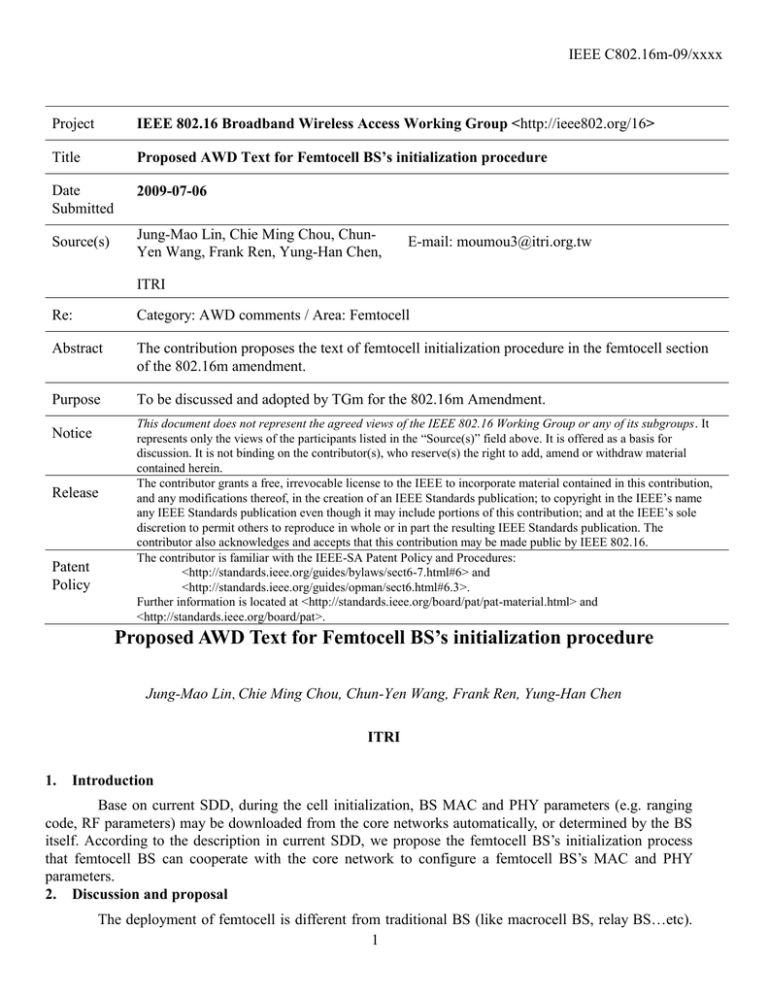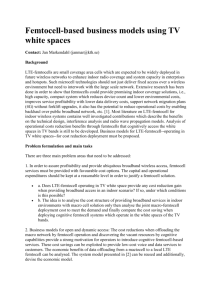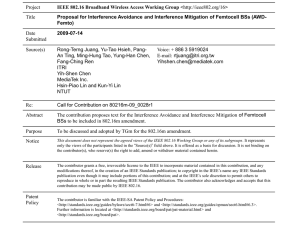IEEE C802.16m-09/xxxx Project Title
advertisement

IEEE C802.16m-09/xxxx
Project
IEEE 802.16 Broadband Wireless Access Working Group <http://ieee802.org/16>
Title
Proposed AWD Text for Femtocell BS’s initialization procedure
Date
Submitted
2009-07-06
Source(s)
Jung-Mao Lin, Chie Ming Chou, ChunYen Wang, Frank Ren, Yung-Han Chen,
E-mail: moumou3@itri.org.tw
ITRI
Re:
Category: AWD comments / Area: Femtocell
Abstract
The contribution proposes the text of femtocell initialization procedure in the femtocell section
of the 802.16m amendment.
Purpose
To be discussed and adopted by TGm for the 802.16m Amendment.
Notice
Release
Patent
Policy
This document does not represent the agreed views of the IEEE 802.16 Working Group or any of its subgroups. It
represents only the views of the participants listed in the “Source(s)” field above. It is offered as a basis for
discussion. It is not binding on the contributor(s), who reserve(s) the right to add, amend or withdraw material
contained herein.
The contributor grants a free, irrevocable license to the IEEE to incorporate material contained in this contribution,
and any modifications thereof, in the creation of an IEEE Standards publication; to copyright in the IEEE’s name
any IEEE Standards publication even though it may include portions of this contribution; and at the IEEE’s sole
discretion to permit others to reproduce in whole or in part the resulting IEEE Standards publication. The
contributor also acknowledges and accepts that this contribution may be made public by IEEE 802.16.
The contributor is familiar with the IEEE-SA Patent Policy and Procedures:
<http://standards.ieee.org/guides/bylaws/sect6-7.html#6> and
<http://standards.ieee.org/guides/opman/sect6.html#6.3>.
Further information is located at <http://standards.ieee.org/board/pat/pat-material.html> and
<http://standards.ieee.org/board/pat>.
Proposed AWD Text for Femtocell BS’s initialization procedure
Jung-Mao Lin, Chie Ming Chou, Chun-Yen Wang, Frank Ren, Yung-Han Chen
ITRI
1.
Introduction
Base on current SDD, during the cell initialization, BS MAC and PHY parameters (e.g. ranging
code, RF parameters) may be downloaded from the core networks automatically, or determined by the BS
itself. According to the description in current SDD, we propose the femtocell BS’s initialization process
that femtocell BS can cooperate with the core network to configure a femtocell BS’s MAC and PHY
parameters.
2. Discussion and proposal
The deployment of femtocell is different from traditional BS (like macrocell BS, relay BS…etc).
1
IEEE C802.16m-09/xxxx
This is because femtocell BS is a plug-and-play device which users may deploy their femtocell BS by
themselves. Based on these characteristics, a lot of femtocell BSs may be developed in a small area with no
unified planning. Therefore, femtocell BS shall have the capability of organizing and configuring its
operating parameters. Due to the limited bandwidth of wireless cellular network; a femtocell BS may use
the same or different carrier frequency with macrocell and neighboring femtocell BSs. We propose an
initialization process for femtocell BS. In this process, network will figure out what the carrier frequency,
radio resource usage, transmitting power suitable for a new femtocell BS based on measurements and
proposed analysis.
Fig 1, overview of self organization and configuration procedure for femtocell BS
The femtocell BS initialization process contains three steps: (a). Information exchange; (b). Femtocellassisted resource selections; (c). Power configuration. The overview for those three steps is described in Figure
1.
(a) Information exchange:
When a femtocell BS intents to operate, it will register to the network and report its basic capability to
network. The basic capability may contain the backhaul capability, legacy MS support and etc. The backhaul
capability of a femtocell BS means the supported data rate of wire line which a femtocell BS plugs in. When
operating, due to few subscribe users, a (CSG)-femtocell BS may not need to operate at every sub-carrier. This
approach can reduce the interference for other ABSs. By the way network needs to decide how maximum radio
resources are enough to be allocated into a femtocell BS. One of the constraints is the backhaul capability. Even
allocating more resources, if the backhaul bandwidth could not support, it will be a waste. By the way, network
needs to make sure the air interface bandwidth can be compatible of the femtocell BS backhaul bandwidth. To
achieve this purpose, network should compute how many resource units (RU) can be supported by the backhaul
bandwidth. An example of calculations is given in equation (1).
RU _ number
BW frame _ duration
-------------------------------(1)
robust _ MCS symbol _ RU
2
IEEE C802.16m-09/xxxx
The RU_number is represented the resource units which provide for femtocell BS. The BW is
represented the backhaul link bandwidth of femtocell BS. The frame_duration is represented the frame duration.
The robust_MCS is represented the minimal guaranteed MCS which femtocell BS shall support. The
symbol_RU is represented the symbol number of each resource unit.
After network computes the required RU numbers, it will record this value and give new femtocell BS
the possible carrier frequency with associated bandwidth. And then a femtocell BS can start next stage to assist
the resources selections.
(b) Femtocell-assisted resource selections:
After femtocell BS receives the information of possible carrier frequency with associated bandwidth
provided by network, it starts measuring the signal quality (ex: received signal strength information, RSSI) of
each carrier frequency and reports the measurement results to network. Based on the reporting, network may
first choose the carrier frequency with minimum RSSI and check the resources usage of that carrier frequency.
The carrier frequency with minimum RSSI represents that other operating ABSs which operate at the carrier
frequency may be far away from this new femtocell BS and they can have low interference with each other.
When checking the resource usage of selecting carrier frequency, network may compare the required resources
of a new femtocell BS with those allocated to surrounding femtocell BSs at this carrier frequency. If reminding
resources (resources that were not used in the frequency carrier for surrounding operating femtocell BSs) are
larger than the required resources of a new femtocell BS, then network can assign the resources to this femtocell
BS and update the usage in network’s database. Otherwise, network may check other frequencies to search
enough resources for further assignment.
If all possible carrier frequency’s reminding resources can’t satisfy the requirements of a new femtocell
BS, then a femtocell BS may apply radio resource reservation scheme for its operation.
The resource selection stage can be run periodically because the network conditions may be changed
when femtocell BSs power on/off in this radio network, and the resource usage will be accordingly dynamic. So
a periodic re-selection would be helpful to re-configure the radio network and optimize it. The period may be
per hour, per day or per week.
(c) Power configuration:
Before a femtocell BS starting its RF power, it needs to adjust the transmission power to verify the
interference level and ensures its self organization is acceptable by other operating ABSs.
The purpose of power configuration procedure is to find an acceptable transmission power for a new
femtocell BS. The whole procedure of power configuration is described in Figure 2. After network assigns
carrier frequency with corresponding resources to a new femtocell BS, network will negotiate with the other
operating ABSs whose geological location are close to this new femtocell BS and operate at the same carrier
frequency as new femtocell BS. During negotiation, network will coordinate a common interval, and resources
for involved ABSs. Besides network will further inform those operating ABSs a dedicated signal with its
transmission power that would be transmitted at coordinated resources. After receiving this information, those
operating ABSs will also send a MES-REQ message to its served AMSs to recommend measuring the dedicated
signal at this common time interval. The message format of MES-REQ message is described in table 1. After
that, network will give the information of the coordinated time interval, resource and dedicated signal to the new
femtocell BS, and request to transmit the dedicated signal at the time interval with transmitting power P_max
(the P_max is constant value which represents the maximum allowable power for a femtocell BS). Both the
associated AMSs and ABSs will receive and measure this signal at the interval. After AMSs measure the signal
strength, they will report the measurement results to their serving ABSs by a MES-RSP message. The message
format of MES-RSP is described in table 2. Those ABSs will calculate an accessible transmission power for
3
IEEE C802.16m-09/xxxx
new femtocell BS and report to network. Network will then choose an acceptable transmission power for new
femtocell BS. Except femtocell BS’s initialization, the power configuration stage can be also triggered by a new
incoming AMS when it suffers a large interference.
Table 1, MES-REQ message format
Field
Size (bits)
Notes
Format of MES-REQ (){
Listening frame number
8
Symbol offset
TBD
Sub-channel offset
TBD
No. symbols
TBD
No. sub-channels
TBD
Dedicated signal sequence
TBD
Transmitted power
TBD
}
Table 2, MES-RSP message format
Field
Size (bits)
Notes
Format of MES-RSP (){
Signal quality
8
}
4
in unit of dBm
IEEE C802.16m-09/xxxx
New femtocell BS
AMS
Operating ABS
Network
Assign carrier frequency with corresponding resources
Coordinate a common time interval,
resources and a dedicated signal
Give time interval, resource and dedicated signal
MES-REQ
Transmit the dedicated signal
Measure signal strength
Measure signal strength
MES-RSP
Calculate an accessible
transmission poser
Report calculating result
Decide a suitable
transmission power
Power configuration results
RF power on
Fig2, power configuration procedure
An example of configuring the transmit power is given in following describing:
In power configuration procedure, network will request femtocell BS1 to transmit dedicated signal with
transmission power P_Max. The operating ABS2 whose geological location is close to femtocell BS1 and
operates at the same carrier frequency will request its served AMS1 to measure the signal quality of the
dedicated signal. If AMS1 measures the signal quality of the dedicated signal is Pr and reports to operating
ABS2. The operating ABS2 can calculate the signaling fading g11 between new femtocell BS1 and AMS1 by
using the equation (2).
g11 P _ Max Pr ------------------------------(2)
According to the CQI report, the operating ABS2 can know the received signal strength PT of AMS1,
PT
then the SINR S of the AMS1 will be
where Pd is total interference power detected by
thermal _ noise Pd
AMS1. If the guaranteed SINR of operating ABS2 is S r , then the Pd can be rewritten as the inequality (3).
Pd
PT
thermal _ noise ---------------------------(3)
Sr
If femtocell BS1 intents to operate and want to satisfy the SINR requirement of AMS1, its transmission
power Pt1 needs to satisfied the inequality (4).
5
IEEE C802.16m-09/xxxx
Pt1
PT
thermal _ noise g11 ------------------------(4)
Sr
g12 is the signal fading between AMS1 and new femtocell BS1. Based on the equation (2), we can
rewrite the inequality (4) as inequality (5).
Pt1
PT
thermal _ noise P _ Max Pr -------------(5)
Sr
Based on the inequality (5), operating ABS2 can calculate a suitable transmission power and make
reports to network.
3.
Proposed AWD Text
Proposed Text for 15.x
---------------------------------------------------- Start of Proposed Text----------------------------------------------------
15.x Femtocell BS Initialization
A femtocell BS can cooperate with the core network to configure its MAC and PHY parameters.
After a newly deployed femtocell BS succeeds in registering to the core network, it negotiates its basic
capability information with core network. During negotiating basic capabilities, a femtocell BS needs to report
its backhaul bandwidth to the core network. A newly deployed femtocell BS can measure the signal quality of
each possible carrier frequency and report the measurement results to core network. The measurement procedure
is the same as cell selections in AMS. Based on the measurement results, the core networks can assign the
carrier frequency and allocations of resource units for femtocell BS’s operating.
Before a newly deployed femtocell BS starting RF power, it needs to adjust the transmission power to verify the
interference level and ensures the configuration is acceptable by other operating BSs. The core network will
coordinate neighborhood operating BSs which operate at the same carrier frequency to perform a sounding
approach. Those operating BSs may send a MES-REQ message to its served AMS to request measuring the
sounding signal transmitted from newly deployed femtocell BS. The message format of MES-REQ message is
described in table XX. AMSs will report the measurement result to its serving BSs by a MES-RSP message.
The message format of MES-RSP message is described in table YY. Those operating BSs could compute an
accessible transmission power for new femtocell BS and report to network. Network will configure the
transmission power for newly deployed femtocell BS based on those operating BSs reporting.
The sounding approach can be also triggered by an AMS when it detects a lot of interference.
The state diagram of sounding approach for a femtocell BS is shown in Figure-xxx.
6
IEEE C802.16m-09/xxxx
New femtocell BS
AMS
Operating ABS
Network
Assign carrier frequency with corresponding resources
Coordinate a common time interval,
resources and a dedicated signal
Give time interval, resource and dedicated signal
MES-REQ
Transmit the dedicated signal
Measure signal strength
Measure signal strength
MES-RSP
Calculate an accessible
transmission poser
Report calculating result
Decide a suitable
transmission power
Power configuration results
RF power on
Figure-xxx, power configuration procedure
Table XX, MES-REQ message format
Field
Size (bits)
Notes
Format of MES-REQ (){
Listening frame number
8
Symbol offset
TBD
Sub-channel offset
8
No. symbols
TBD
No. sub-channels
TBD
Dedicated signal
TBD
Transmitted power
TBD
}
Table YY, MES-RSP message format
7
IEEE C802.16m-09/xxxx
Field
Size (bits)
Notes
Format of MES-RSP (){
Signal quality
8
in unit of dBm
}
---------------------------------------------------- End of Proposed Text ------------------------------------------------
8


